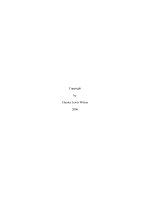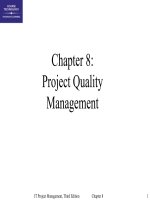Testbank of fundamental of management 7e by robin ch 08
Bạn đang xem bản rút gọn của tài liệu. Xem và tải ngay bản đầy đủ của tài liệu tại đây (164.38 KB, 45 trang )
Fundamentals of Management, 7e (Robbins/DeCenzo/Coulter)
Chapter 8 Foundations of Individual Behavior
1) One of the challenges in understanding organizational behavior is that it addresses issues that
aren't obvious.
Answer: TRUE
Explanation: Behavior within an organization has been compared to an iceberg. Many aspects of
the organization are visible, but just as many aspects are hidden from view but nevertheless have
profound effect on the organization itself.
Diff: 2
Page Ref: 214
Objective: 8.1
2) Organizational behavior is primarily concerned with group interactions.
Answer: FALSE
Explanation: Organizational behavior is concerned with both group and individual behavior, as
well as various organizational aspects that include the structure, culture and human resource
policies of organizations.
Diff: 2
Page Ref: 214
Objective: 8.1
3) The goals of OB are to explain, predict, and understand behavior.
Answer: FALSE
Explanation: The goals of OB are to explain, predict, and influence, rather than understand
behavior.
Diff: 1
Page Ref: 215
Objective: 8.1
4) Attitudes are evaluative statements concerning objects, people, or events.
Answer: TRUE
Explanation: Attitudes are statements that reveal an assessment of something that can be
favorable or unfavorable.
Diff: 2
Page Ref: 215
Objective: 8.1
5) Individuals try to reconcile attitudes and behavior so they are both rational and consistent.
Answer: TRUE
Explanation: Research and common experience both indicate that individuals like to be
consistent with respect to attitudes and behavior. Another way of seeing this issue is that people
do not like to be seen as hypocrites—they try to do what they say they believe in.
Diff: 2
Page Ref: 217
AACSB: Reflective Thinking
Objective: 8.2
6) Cognitive dissonance arises when people feel that their behavior and attitudes are consistent.
Answer: FALSE
Explanation: Dissonance occurs when individuals feel that they are being inconsistent, not
consistent.
Diff: 2
Page Ref: 218
Objective: 8.2
1
Copyright © 2011 Pearson Education, Inc
7) The discomfort that results from high dissonance can be reduced when an individual feels that
she has a choice in the matter.
Answer: FALSE
Explanation: In fact, not having a choice usually makes a person feel better about dissonance
than having a choice. Not having a choice takes the responsibility off of the individual, and so
relieves the discomfort of dissonance.
Diff: 2
Page Ref: 218
AACSB: Analytic Skills
Objective: 8.2
8) Research shows that high job satisfaction correlates with high productivity.
Answer: TRUE
Explanation: In general, the more satisfied a person is with his or her job, the more productive
he or she is likely to be.
Diff: 2
Page Ref: 219
Objective: 8.2
9) Personality is defined as a unique combination of behavioral, emotional, and thinking patterns
that each person has.
Answer: TRUE
Explanation: These patterns can be identified by personality tests such as the Myers-Briggs Type
Indicator® and the Big Five model.
Diff: 2
Page Ref: 220-221
Objective: 8.3
10) The Myers-Briggs Type Indicator® test can identify thousands of different basic personality
types.
Answer: FALSE
Explanation: The Myers-Briggs Type Indicator® recognizes sixteen different basic personality
types, based on four personality dichotomies.
Diff: 2
Page Ref: 220-221
Objective: 8.3
11) In the Big Five model, emotional security was positively related to job performance.
Answer: FALSE
Explanation: Surprisingly, Big Five model research showed that individuals who were
emotionally secure tended to have low job performance.
Diff: 2
Page Ref: 222
Objective: 8.3
12) The ability to control one's own emotions is an important component in emotional
intelligence.
Answer: TRUE
Explanation: Controlling one's emotions and impulses is termed self-management.
Diff: 2
Page Ref: 222
Objective: 8.3
2
Copyright © 2011 Pearson Education, Inc
13) Emotional intelligence and academic intelligence are virtually identical.
Answer: FALSE
Explanation: Though the same individual can exhibit both emotional and academic intelligence,
the two metrics are very different. For example, a person with high EI can have low academic
intelligence, and vice versa.
Diff: 2
Page Ref: 222
Objective: 8.3
14) A worker with an external locus of control would tend to blame failure on himself.
Answer: FALSE
Explanation: Rather than himself, a worker with an external locus of control would tend to
blame failure on external sources, such as outside conditions or unfair treatment.
Diff: 2
Page Ref: 223
Objective: 8.3
15) A high Mach person tends to think that ends justify means.
Answer: TRUE
Explanation: A key to the high Mach personality is that it focuses on results and not the path—
ethical or unethical—that a person takes to reach a goal.
Diff: 2
Page Ref: 223
Objective: 8.3
16) Employees with high self-esteem tend to be more satisfied with their jobs than low SEs.
Answer: TRUE
Explanation: High SE individuals tend to correlate with high job satisfaction, perhaps because
they are able to derive more fulfillment out of the work itself rather than the praise they get from
doing the work.
Diff: 2
Page Ref: 223
Objective: 8.3
17) A low self-monitoring employee would be likely to be a good poker player.
Answer: FALSE
Explanation: Low self-monitoring individuals would not have the ability to conceal their
feelings, and would therefore tend to "give away" their hand in a poker game.
Diff: 3
Page Ref: 223
AACSB: Analytic Skills
Objective: 8.3
18) A person who is risk-averse might do well as a stock trader.
Answer: FALSE
Explanation: Stock trading is a high pressure, high risk enterprise in which decisions need to be
made quickly on little information. People who are risk-takers tend to do well in this kind of job.
Diff: 2
Page Ref: 224
Objective: 8.3
3
Copyright © 2011 Pearson Education, Inc
19) According to John Holland, the key to job success is how well an individual's personality
matches his or her job.
Answer: TRUE
Explanation: Holland thinks that people do have clear intrinsic personality types. A better fit
between personality type and job type results in higher job satisfaction.
Diff: 2
Page Ref: 224
Objective: 8.3
20) According to John Holland's theory, a realistic personality type might be well-suited to be an
economist.
Answer: FALSE
Explanation: A realistic personality type would tend to prefer physical activities, something that
an economist would typically not do. Therefore, the statement is false.
Diff: 2
Page Ref: 224
Objective: 8.3
21) People from the Middle East tend to believe that life is not predetermined and they can
control their own destiny.
Answer: FALSE
Explanation: To the contrary, people from Middle Eastern countries tend to be fatalistic and
think that life is predetermined.
Diff: 2
Page Ref: 225
AACSB: Diversity
Objective: 8.3
22) U.S. workers, more than Iranian workers, would likely have an external locus of control.
Answer: FALSE
Explanation: U.S. workers, who come from a more individualistic culture in which people
depend on their own talents and resources, tend to have a more internal, not external, locus of
control.
Diff: 2
Page Ref: 225
AACSB: Diversity
Objective: 8.3
23) A fundamental idea of perception is that all people interpret and distort reality in some way.
Answer: TRUE
Explanation: Perception is subjective. No one sees fully objective reality. Everyone interprets
what he or she sees and distorts to a certain degree.
Diff: 2
Page Ref: 226
Objective: 8.4
24) Distortion of perception can only come from the person who is perceiving.
Answer: FALSE
Explanation: The target can also distort perception. For example, a loud person is more likely to
be noticed than a quiet person.
Diff: 2
Page Ref: 226
Objective: 8.4
4
Copyright © 2011 Pearson Education, Inc
25) Attribution theory is primarily concerned with identifying one's own behavior.
Answer: FALSE
Explanation: Attribution theory is concerned with determining whether the cause of others'
behavior is external or internal.
Diff: 1
Page Ref: 227
Objective: 8.4
26) Distinctiveness refers to whether an individual displays a behavior in many situations or
whether it's particular to one situation.
Answer: TRUE
Explanation: High distinctiveness means you see this behavior only for this particular task and
not for related tasks. Low distinctiveness means the behavior is general for any related task.
Diff: 2
Page Ref: 227
AACSB: Analytic Skills
Objective: 8.4
27) The fundamental attribution error states that individuals tend to overestimate the influence of
external factors in others.
Answer: FALSE
Explanation: To the contrary, the fundamental attribution error assumes too much internal
influence in the behavior of others.
Diff: 3
Page Ref: 227
AACSB: Reflective Thinking
Objective: 8.4
28) Individuals tend to attribute their own successes to external factors.
Answer: FALSE
Explanation: Individuals tend to attribute success to inner qualities such as effort and talent,
rather than external qualities such as good fortune.
Diff: 3
Page Ref: 227
AACSB: Reflective Thinking
Objective: 8.4
29) In stereotyping, observers use group characteristics to judge individuals.
Answer: TRUE
Explanation: For example, an observer resorts to stereotyping when he assumes that a person of
a particular ethnic group will be a "hard worker."
Diff: 2
Page Ref: 228
Objective: 8.4
30) Perceptual shortcuts are not necessarily distorted.
Answer: TRUE
Explanation: Perceptual shortcuts can be valuable for making quick assessments of people and
situations. The danger of perceptual shortcuts is to rely on them too much or fail to go beyond an
initial impression.
Diff: 2
Page Ref: 229
Objective: 8.4
5
Copyright © 2011 Pearson Education, Inc
31) Operant behavior deals only with learned behavior.
Answer: TRUE
Explanation: Operant behavior does not deal with innate or reflexive behavior.
Diff: 1
Page Ref: 229
Objective: 8.5
32) In operant conditioning, if behavior is positively reinforced it is less likely to repeat.
Answer: FALSE
Explanation: The opposite is true—positively reinforced behavior is more, not less likely to
repeat.
Diff: 2
Page Ref: 229
Objective: 8.5
33) Skinner would argue that a dog responding to a whistle is an innate or unlearned behavior.
Answer: FALSE
Explanation: Skinner would argue that the behavior was learned—the dog must have been
rewarded for the behavior in some way.
Diff: 2
Page Ref: 230
Objective: 8.5
34) Classical conditioning predicts that hearing music from a familiar horror movie might cause
a person to feel anxious.
Answer: TRUE
Explanation: Classical conditioning predicts that the association between the music and the
sense of fright causes the person to feel anxious.
Diff: 2
Page Ref: 230
Objective: 8.5
35) Social learning theory maintains that models who are different from ourselves have the
greatest influence on our behavior.
Answer: FALSE
Explanation: Social learning theory states that people pay most attention to models who are
similar, not different from themselves.
Diff: 1
Page Ref: 231
Objective: 8.5
36) When a manager praises an employee for a job well done, she is providing positive
reinforcement.
Answer: TRUE
Explanation: Positive reinforcement supplies a reward for a desired behavior. Praise is a form of
reward.
Diff: 2
Page Ref: 231
Objective: 8.5
6
Copyright © 2011 Pearson Education, Inc
37) Negative reinforcement penalizes an individual for an undesired behavior.
Answer: FALSE
Explanation: Penalizing an individual for undesired behavior is called punishment, not negative
reinforcement. Negative reinforcement is the withdrawal of an unpleasant stimulus.
Diff: 2
Page Ref: 231
Objective: 8.5
38) Negative reinforcement is the withdrawal of something unpleasant.
Answer: TRUE
Explanation: Withdrawing some kind of unpleasant stimulus is negative reinforcement.
Diff: 2
Page Ref: 231
Objective: 8.5
39) Gen Y individuals are those people who were born after 1997.
Answer: FALSE
Explanation: Gen Y people are defined as individuals who were born from 1982 to 1997.
Diff: 2
Page Ref: 233
Objective: 8.6
40) Gen Y individuals tend to be comfortable with new types of electronic technology.
Answer: FALSE
Explanation: Most Gen Y individuals grew up with many kinds of electronic devices so they are
comfortable with new devices.
Diff: 2
Page Ref: 233
Objective: 8.6
41) Which of the following best defines organizational behavior?
A) the actions of organizations in the workplace
B) the study of the workplace
C) the study of organizations
D) the study of the actions of people at work
Answer: D
Explanation: D) Organizational behavior, OB, is not merely a study of the workplace, of
organizations in isolation, or of the actions of organizations in the workplace. Instead, OB
focuses on people and their actions within the workplace while they are at work. This makes the
study of the actions of people at work the best definition of OB and the correct response.
Diff: 1
Page Ref: 214
Objective: 8.1
7
Copyright © 2011 Pearson Education, Inc
42) Hidden aspects of an organization that OB provides insight into include ________.
A) strategies
B) attitudes
C) structure
D) objectives
Answer: B
Explanation: B) Strategies, structure, and objectives are visible, not hidden, aspects of
organizations so they are incorrect responses. Hidden responses include the attitudes that
employees carry with them on the job, making attitudes the correct response.
Diff: 2
Page Ref: 214
Objective: 8.1
43) Which of the following is a visible aspect of an organization?
A) attitudes
B) interpersonal conflicts
C) intergroup conflicts
D) objectives
Answer: D
Explanation: D) The attitudes, and both interpersonal and intergroup conflicts that arise within
organizations are all hidden aspects of organizations. Objectives, on the other hand, are explicit,
non-hidden, visible aspects of an organization, making that the correct response for this question.
Diff: 2
Page Ref: 214
Objective: 8.1
44) Organizational behavior focuses on ________.
A) individual behavior and group behavior
B) group behavior only
C) individual behavior only
D) neither group behavior nor individual behavior
Answer: A
Explanation: A) OB focuses on both individual and group behavior, making that the correct
response and eliminating the other responses. A third major area that OB is concerned with are
organizational aspects that include the structure, culture, and human resource policies and
practices of organizations.
Diff: 2
Page Ref: 215
Objective: 8.1
45) Which of the following are the goals of organizational behavior?
A) to explain, understand, and control behavior
B) to control and influence behavior
C) to explain, predict, and influence behavior
D) to predict, understand, and change behavior
Answer: C
Explanation: C) OB's official goals are to explain, predict, and influence behavior, making that
the correct response. All other choices can be ruled out because they include at least one
incorrect goal.
Diff: 2
Page Ref: 215
Objective: 8.1
8
Copyright © 2011 Pearson Education, Inc
46) When managers influence employee behavior they ________.
A) predict what employees will do
B) steer it in a particular direction
C) understand why a behavior occurs
D) try not to change a behavior
Answer: B
Explanation: B) Influencing behavior means that managers change the behavior in some way.
Predicting or understanding behavior does not change any aspect of behavior itself, so those two
choices can be ruled out as correct responses, as well as trying not to change behavior. This
leaves "steering it in a particular direction" as the correct response—when they influence
behavior managers try to steer the behavior into one particular direction that is beneficial to the
organization.
Diff: 2
Page Ref: 215
Objective: 8.1
47) All of the following are included in the six behaviors that managers try to explain, predict,
and influence EXCEPT ________.
A) productivity and absenteeism
B) workplace attitudes and perceptions
C) workplace misbehavior and turnover
D) organizational citizenship behavior and job satisfaction
Answer: B
Explanation: B) Managers try to explain, predict, and influence the following six behaviors:
productivity, absenteeism, workplace misbehavior, turnover, organizational citizenship behavior,
and job satisfaction. This rules out the three incorrect responses as correct answers since they
include the identified behaviors above. Attitudes and perceptions are not among the behaviors
that managers focus on, so workplace attitudes and perceptions is the correct response.
Diff: 2
Page Ref: 215
Objective: 8.1
48) This "behavior" is really an attitude.
A) job satisfaction
B) turnover
C) workplace misbehavior
D) employee productivity
Answer: A
Explanation: A) Behaviors are defined as actions that individuals take. Productivity is a behavior
because it involves working, an action, in an efficient way. Turnover, or quitting a job, is
definitely an action, so it too is a behavior. Workplace misbehavior involves troubling actions
that employees take, so it also qualifies as a behavior. Job satisfaction is actually a feeling that
employees have about their jobs, not an action that they take, so it is not really a behavior,
making job satisfaction the correct response.
Diff: 2
Page Ref: 215
Objective: 8.1
9
Copyright © 2011 Pearson Education, Inc
49) Of the six behaviors that managers focus on, which behavior is typically the most troubling
to an organization?
A) absenteeism
B) workplace misbehavior
C) organizational citizenship behavior
D) employee productivity
Answer: B
Explanation: B) Employee productivity and organizational citizenship behavior are both positive
behaviors, so they are not troubling at all to managers. Absenteeism is troubling, but it is not as
severe a problem as workplace misbehavior, which can include violence and abuse, making
workplace misbehavior the correct response for this question.
Diff: 3
Page Ref: 215-216
AACSB: Ethical Understanding and Reasoning Abilities
Objective: 8.1
50) ________ is a performance measure of both efficiency and effectiveness of employees.
A) Employee productivity
B) Organizational citizenship behavior
C) Job satisfaction
D) Turnover
Answer: A
Explanation: A) Job satisfaction, organizational citizenship behavior, and turnover are not in any
direct way related to efficiency or effectiveness, so they are incorrect responses. Productivity, on
the other hand, is a way to measure how much an employee gets done on the job, so it is a
measure of efficiency and effectiveness, making employee productivity the correct response.
Diff: 2
Page Ref: 215
Objective: 8.1
51) The three elements that make up an attitude are its ________ components.
A) cognitive, affective, and behavioral
B) affective, effective, and defective
C) cognitive, component, and affective
D) behavioral, cognitive, and misbehavioral
Answer: A
Explanation: A) The three components are cognitive (beliefs, knowledge), affective (emotional),
and behavioral (actions), making cognitive, affective, and behavioral the correct response. All
other responses contain at least one erroneous component.
Diff: 2
Page Ref: 216
Objective: 8.2
10
Copyright © 2011 Pearson Education, Inc
52) The component of attitude that is made up of knowledge and information is ________.
A) cognitive
B) behavioral
C) affective
D) practices
Answer: A
Explanation: A) The three components of an attitude have to do with what you think and know
(cognitive), how you feel (affective), and how you act on what you think and feel (behavioral).
As the component that is involved with thoughts and information, cognitive is the correct
response for this question. Practices can be ruled out because practices are not thought to be a
component of an attitude.
Diff: 2
Page Ref: 216
Objective: 8.2
53) When you stand at attention during the playing of the national anthem you are revealing
which component of your attitude toward your country?
A) cognitive
B) affective
C) metacognitive
D) behavioral
Answer: D
Explanation: D) Standing at attention is more than knowledge, a belief (cognition), or a feeling
(affect) about your country, it is an action or a behavior, making behavioral the correct response.
Note that metacognitive is not a component of an attitude, so that is an incorrect response.
Diff: 3
Page Ref: 216
Objective: 8.2
54) The ________ component of attitude is based on emotions.
A) cognitive
B) behavioral
C) affective
D) action
Answer: C
Explanation: C) Attitudes are thought to have three main components: cognition, affect, and
behavior. An attitude starts with the knowledge, thoughts, and beliefs that a person has on a
subject, the cognitive part of attitude. The emotional feeling that results from this knowledge,
thoughts, and beliefs is termed the affect, making affective the correct response. Both behavioral
and action can be ruled out because they refer to actions, not emotions or feelings.
Diff: 2
Page Ref: 216
Objective: 8.2
11
Copyright © 2011 Pearson Education, Inc
55) Wendy spent several hours looking over an architect's plans and forming an impression for a
new building design. Which component of attitude did she carry out?
A) affective
B) behavioral
C) emotive
D) cognitive
Answer: D
Explanation: D) In gathering information, Wendy is clearly carrying out the cognitive
component of attitude, making cognitive the correct response. She has not formed any feelings
about the building, which rules out affective and emotive as correct responses. Wendy has also
not acted on her impressions or feelings, eliminating behavioral as a correct response.
Diff: 3
Page Ref: 216
Objective: 8.2
56) After carefully examining the architect's plans yesterday, today Wendy has decided that she
loves the new design. Which component of forming an attitude did she carry out today?
A) cognitive
B) affective
C) behavioral
D) informational
Answer: B
Explanation: B) Wendy's love of the new design is an emotional feeling or affect, making
affective the correct response. She carried out the cognitive component of attitude (gathering
information) yesterday rather than today—causing cognitive and informational to be eliminated
as a correct answer. Wendy has also not yet acted on her impressions or feelings, eliminating
behavioral as a correct response.
Diff: 2
Page Ref: 216
Objective: 8.2
57) After deciding that she likes the architect's new building design this morning, this afternoon
Wendy has decided to go ahead with the project. Which component of attitude did she use this
afternoon?
A) cognitive
B) behavioral
C) emotive
D) affective
Answer: B
Explanation: B) Wendy's decision to "green light" the project is an intention to carry out an
action or behavior, making behavioral the correct response. The behavioral component is the
final part of attitude formation, making the cognitive and affective (emotive, affective)
components of attitude incorrect responses for this question because those components had
already been completed prior to this afternoon's action.
Diff: 3
Page Ref: 216
Objective: 8.2
12
Copyright © 2011 Pearson Education, Inc
58) In everyday parlance, the term attitude refers only to the ________ component of attitude.
A) cognitive
B) informational
C) behavioral
D) affective
Answer: D
Explanation: D) The term attitude commonly refers to only the affective, or emotional
component of an attitude, making affective the correct response. The cognitive and behavioral
components of attitude are part of every attitude, but they are often not explicitly referred to.
Diff: 1
Page Ref: 216
Objective: 8.2
59) A manager would most likely be interested in employees' attitudes about which of the
following?
A) family responsibility
B) personal responsibility
C) job satisfaction
D) past jobs
Answer: C
Explanation: C) Managers are most interested in attitudes that affect the performance of
employees on the job. Family or personal responsibility may be important to a person, but they
are unlikely to affect job performance as much as job satisfaction. Similarly, attitudes toward
past jobs may affect employee performance to a small degree, but not nearly to the degree that
job satisfaction affects the employee in his or her current position, making job satisfaction the
correct response.
Diff: 2
Page Ref: 216
Objective: 8.2
60) The degree to which an employee identifies with his or her job or actively participates in it
refers to the employee's ________.
A) job involvement
B) organizational commitment
C) global commitment
D) job satisfaction
Answer: A
Explanation: A) Job involvement doesn't measure an employee's commitment to a corporation or
an organization, but rather, it reflects the employee's identification and "ownership" of a
particular job, making job involvement the correct response. Job satisfaction measures how
happy or unhappy an employee is with a job, not how much the person identifies with the job,
making job satisfaction an incorrect response.
Diff: 3
Page Ref: 216
Objective: 8.2
13
Copyright © 2011 Pearson Education, Inc
61) An employee who brags about her company to friends and recommends all company
products as gifts is likely to have high ________.
A) job involvement
B) organizational commitment
C) personal commitment
D) organizational citizenship
Answer: B
Explanation: B) This employee's actions show pride in, and identification with the organization
itself, not the job that she has. Organizational citizenship and job involvement would both be
oriented more toward the job itself than the organization, so the correct answer here is
organizational commitment. Personal commitment is not correct because it refers to a personal,
not an organizational commitment.
Diff: 3
Page Ref: 216
AACSB: Analytic Skills
Objective: 8.2
62) With respect to employee engagement in a job, this seems to be the most important factor to
employees around the world.
A) base pay
B) respect
C) benefits
D) type of work
Answer: B
Explanation: B) While base pay, benefits, and type of work are all important to varying degrees
to workers, studies show respect is the number one factor in determining employee engagement
in a job. Workers who are shown respect show the most engagement in their jobs.
Diff: 2
Page Ref: 217
AACSB: Diversity
Objective: 8.2
63) The country that seems to value respect more than any other country is ________.
A) the United States
B) the United Kingdom
C) China
D) France
Answer: B
Explanation: B) Though workers in the United States, China, and France all think respect is
important, the country that gives respect its highest value in employee engagement studies is the
United Kingdom.
Diff: 2
Page Ref: 217
AACSB: Diversity
Objective: 8.2
14
Copyright © 2011 Pearson Education, Inc
64) In this country, the type of work one does is valued above all other factors with respect to
employee engagement.
A) China
B) India
C) Japan
D) France
Answer: D
Explanation: D) India, Japan, and especially China all gave "type of work" relatively low scores
when compared to other factors such as "respect" in studies that measured factors that were
important for employee engagement. In France, however, the type of work one does ranks
number one in importance with respect to employee engagement.
Diff: 2
Page Ref: 217
AACSB: Diversity
Objective: 8.2
65) Cognitive dissonance theory states that a person feels ________ when his attitudes and
actions don't match.
A) comfortable
B) uncomfortable
C) confused
D) confident
Answer: B
Explanation: B) A clash between attitudes and actions is likely to make a person feel like a
hypocrite—that is, he is not living up to who he says he is. Seeing oneself as hypocritical would
tend to make a person feel uncomfortable rather than confused. Feeling comfortable or confident
would probably be somewhat the opposite of the way the person who was feeling dissonance
would actually feel, which rules out those two choices as correct responses.
Diff: 2
Page Ref: 218
Objective: 8.2
66) The cognitive dissonance theory proposes that the factors that can mitigate the discomfort
caused by dissonance are ________.
A) importance, influence, and rewards
B) influence, rewards, and goals
C) importance, goals, and status
D) influence, reinforcement, and rewards
Answer: A
Explanation: A) The three determining factors for controlling discomfort from cognitive
dissonance are importance, influence, and rewards. The other three choices can all be eliminated
because they all include at least one incorrect determining factor.
Diff: 1
Page Ref: 218
Objective: 8.2
15
Copyright © 2011 Pearson Education, Inc
67) A person who is being hypocritical about something that has high importance in her life
would be likely to experience ________ discomfort from cognitive dissonance.
A) low
B) no
C) high
D) minimal
Answer: C
Explanation: C) All other things being equal, if a person is being hypocritical about something
that is very meaningful to her, she will experience high discomfort from cognitive dissonance,
making that the correct response. This discomfort can be tempered if the dissonance is shown to
be caused by something that she cannot control (low influence) or she receives some kind of
large compensation for her effort (high reward).
Diff: 2
Page Ref: 218
AACSB: Ethical Understanding and Reasoning Abilities
Objective: 8.2
68) A person who is experiencing cognitive dissonance might have his discomfort from the
dissonance reduced if he has ________ control over his actions.
A) some
B) total
C) almost total
D) little or no
Answer: D
Explanation: D) Having some, total, or almost total control over one's actions increases, rather
than decreases, discomfort from dissonance. The more you feel that you are responsible for your
actions (the more control you have), the more discomfort you are likely to experience. This
eliminates "some," "total," and "almost total" as correct responses and makes "little or no" the
right answer. Having little or no control over your actions makes you feel less uncomfortable
about the actions themselves.
Diff: 3
Page Ref: 218-219
AACSB: Ethical Understanding and Reasoning Abilities
Objective: 8.2
69) Taking a job in a repressive country that you disapprove of politically might cause
discomfort from dissonance unless ________.
A) the job suits you well
B) the job offers enormous pay
C) the job offers little pay
D) the job does not suit you well
Answer: B
Explanation: B) Discomfort from dissonance can be mitigated by a high reward. This makes the
job offering enormous pay the correct response since it offers high pay and eliminates the choice
regarding little pay because it's a low reward. How well the job suits you would not be likely to
be a strong enough reward to mitigate any discomfort you might feel from taking the job, so "the
job suiting you well" or "the job not suiting you well" are incorrect.
Diff: 3
Page Ref: 218-219
AACSB: Ethical Understanding and Reasoning Abilities
Objective: 8.2
16
Copyright © 2011 Pearson Education, Inc
70) After the disappointment of not getting a new position, an employee states, "That job looks
like a real headache, anyway." This is an example of ________ to reduce discomfort from
dissonance.
A) reducing importance
B) increasing importance
C) reducing influence
D) increasing influence
Answer: A
Explanation: A) The statement is a rationalization that attempts to minimize the importance of
the new position, making reducing importance the correct response and ruling out increasing
importance. The statement has no connection to reducing or increasing influence, since influence
involves control over the decision and the employee's statement did not reduce or increase his
control over the decision.
Diff: 3
Page Ref: 218-219
AACSB: Ethical Understanding and Reasoning Abilities
Objective: 8.2
71) Which of the following are typically the most important reasons for why managers want to
increase positive job attitudes?
A) lower rates of turnover and absenteeism
B) higher rates of turnover and absenteeism
C) to decrease worker unhappiness
D) to increase worker happiness
Answer: A
Explanation: A) Ultimately, productivity is the manager's goal and can typically be achieved
only with less turnover and absenteeism, making lower rates of turnover and absenteeism the
correct response and eliminating higher rates. Whether or not workers are happy might be
important to a manager, but not nearly as important as productivity, so decreasing or increasing
worker happiness are ruled out as possible correct answers.
Diff: 2
Page Ref: 219
Objective: 8.2
72) Studies show that the statement, "Happy workers are productive workers" is ________
A) completely false
B) completely true
C) fairly true
D) largely false
Answer: C
Explanation: C) The evidence shows a fairly strong correlation between job satisfaction and
productivity, indicating that "fairly true" is the correct response here and eliminating the other
choices. The correct answer is only "fairly true" rather than "completely true" because the
correlational evidence, though strong, still cannot completely distinguish whether job satisfaction
creates high productivity or vice versa—that the sense of accomplishment that people get from
high productivity creates job satisfaction.
Diff: 2
Page Ref: 219
Objective: 8.2
73) To reduce dissonance in the workplace, managers are advised to hold ________ responsible
for the causes of the dissonance.
A) employees
17
Copyright © 2011 Pearson Education, Inc
B) both employees and management
C) fellow workers
D) external forces
Answer: D
Explanation: D) To reduce dissonance, managers are advised to shift responsibility for the
dissonance-producing actions of employees from themselves to outside sources. These sources
might include management, competitors, customers, or some other external force. These facts
make external forces the correct response and eliminate the other three choices as possible
correct responses.
Diff: 2
Page Ref: 219
Objective: 8.2
74) Rather than try to make employees happy, managers might do well to focus on making work
________.
A) easy to accomplish
B) challenging and interesting
C) challenging and difficult
D) simple rather than complex
Answer: B
Explanation: B) One of the keys to high productivity is that employees find their work
interesting and challenging, making that the correct response. Work that is too easy, too hard, or
overly simple has not been shown to be conducive to high worker productivity so these choices
can be ruled out.
Diff: 3
Page Ref: 219
Objective: 8.2
75) ________ is the unique combination of psychological traits that describe a person.
A) Character
B) Intelligence
C) Behavior
D) Personality
Answer: D
Explanation: D) Personality is defined as the combination of emotional patterns, thought
patterns, and behavioral patterns that make a person unique and special. None of the other
choices fits this definition, so character, intelligence, and behavior are all incorrect responses.
Diff: 1
Page Ref: 220
Objective: 8.3
18
Copyright © 2011 Pearson Education, Inc
76) The Myers-Briggs Type Indicator® (MBTI®) is based on ________ that are revealed in a
100-item questionnaire.
A) two dichotomies
B) four dichotomies
C) four personality types
D) eight personality types
Answer: B
Explanation: B) The Myers-Briggs Type Indicator® is based on four separate dichotomies that
determine whether a person is: extroverted or introverted, sensing or intuitive, thinking or
feeling, or judging or perceiving. This makes four dichotomies the correct response and
eliminates two dichotomies. Four and eight personality types are incorrect because the MyersBriggs Type Indicator® reveals sixteen personality types, not four or eight.
Diff: 3
Page Ref: 220
Objective: 8.3
77) The extroversion versus introversion scale on the Myers-Briggs Type Indicator® determines
whether a person is oriented ________.
A) outwardly or inwardly
B) toward gathering data or the big picture
C) logically or emotionally
D) toward planning or flexibility
Answer: A
Explanation: A) The extroversion-introversion scale of the Myers-Briggs Type Indicator®
focuses primarily on whether a person is oriented in an outward or inward direction, making that
the correct response. Gathering data describes the sensing-intuition scale, so it is an incorrect
response. Logically or emotionally describes the thinking-feeling scale, so it is an incorrect
response. Planning or flexibility describes the judging-perceiving scale, so it is an incorrect
response.
Diff: 3
Page Ref: 220
Objective: 8.3
78) The judging versus perceiving scale on the Myers-Briggs Type Indicator® determines
whether a person is oriented ________.
A) outwardly or inwardly
B) toward gathering data or the big picture
C) toward planning or flexibility
D) logically or emotionally
Answer: C
Explanation: C) The judging-perceiving scale of the Myers-Briggs Type Indicator® focuses
primarily on whether a person is oriented toward planning or flexibility in dealing with important
issues, making that the correct response. Gathering data describes the sensing-intuition scale, so
it is an incorrect response. Logically or emotionally describes the thinking-feeling scale, so it is
an incorrect response. Outwardly or inwardly describes the introversion-extroversion scale, so it
is an incorrect response.
Diff: 3
Page Ref: 220
Objective: 8.3
19
Copyright © 2011 Pearson Education, Inc
79) The thinking versus feeling scale on the Myers-Briggs Type Indicator® determines whether a
person is oriented ________.
A) logically or emotionally
B) toward gathering data or the big picture
C) outwardly or inwardly
D) toward planning or flexibility
Answer: A
Explanation: A) The thinking-feeling scale of the Myers-Briggs Type Indicator® focuses
primarily on whether a person is oriented in a logical or an emotional way, making that the
correct response. Gathering data describes the sensing-intuition scale, so it is an incorrect
response. Outwardly or inwardly describes the extroversion-introversion scale, so it is an
incorrect response. Planning or flexibility describes the judging-perceiving scale, so it is an
incorrect response.
Diff: 3
Page Ref: 220
Objective: 8.3
80) The sensing versus intuition scale on the Myers-Briggs Type Indicator® determines whether
a person is oriented ________.
A) outwardly or inwardly
B) toward gathering data or the big picture
C) logically or emotionally
D) toward planning or flexibility
Answer: B
Explanation: B) The sensing-intuition scale of the Myers-Briggs Type Indicator® focuses
primarily on whether a person is oriented toward gathering data to form an impression, or
looking at a wider, more big-picture view, making gathering data the correct response. Outwardly
or inwardly describes the extroversion-introversion scale, so it is an incorrect response. Logically
or emotionally describes the thinking-feeling scale, so it is an incorrect response. Planning or
flexibility describes the judging-perceiving scale, so it is an incorrect response.
Diff: 3
Page Ref: 220
Objective: 8.3
81) If you are a person who dislikes making plans, you would probably score high on which
aspect of the Myers-Briggs Type Indicator®?
A) more extrovert than introvert
B) more introvert than extrovert
C) more judging than perceiving
D) more perceiving than judging
Answer: D
Explanation: D) More extrovert or more introvert can be ruled out because the EI scale measures
whether you are outwardly or inwardly oriented, neither of which deals with making plans. A
judging person tends to be a plan-maker, while a perceiving person tends to be spontaneous and
flexible and might dislike the sense of confinement that plans engender. This makes more
perceiving than judging the correct response and rules out more judging than perceiving as a
correct answer.
Diff: 3
Page Ref: 220
AACSB: Reflective Thinking
Objective: 8.3
20
Copyright © 2011 Pearson Education, Inc
82) If you are a person who prefers to focus on the big picture when you make a decision, you
would probably score high on which aspect of the Myers-Briggs Type Indicator®?
A) sensing more than intuition
B) intuition more than sensing
C) thinking more than feeling
D) feeling more than thinking
Answer: B
Explanation: B) Thinking more than feeling and feeling more than thinking can be ruled out
because the TF scale measures whether you are logical or emotional, both of which could include
a "big picture" orientation. An intuitive person tends to want to look at the big picture as opposed
to gathering facts and details, making intuition more than sensing the correct response and ruling
out sensing more than intuition as a correct answer.
Diff: 3
Page Ref: 220
AACSB: Reflective Thinking
Objective: 8.3
83) The Big Five model of personality includes all of the following exceot ________.
A) extroversion
B) agreeableness
C) conscientiousness
D) intuitiveness
Answer: D
Explanation: D) The Big Five model of personality includes extroversion, agreeableness,
conscientiousness, emotional stability, and openness to experience. This makes intuitiveness the
correct response, because intuitiveness is the only personality dimension that is not part of the
Big Five.
Diff: 1
Page Ref: 221-222
Objective: 8.3
84) Job studies show that this Big Five personality dimension was consistently important for
success no matter what the job type.
A) extraversion
B) conscientiousness
C) openness to experience
D) emotional stability
Answer: B
Explanation: B) Though extraversion was shown to correlate to success in sales positions, and
openness to experience successfully predicted training success, the only dimension that seemed
to predict success for all job types was conscientiousness, making conscientiousness the correct
response. Note that emotional stability actually predicted lack of success in job performance, so
it cannot be the correct response for this question.
Diff: 2
Page Ref: 221-222
Objective: 8.3
21
Copyright © 2011 Pearson Education, Inc
85) Surprisingly, studies show that emotional security is ________.
A) positively related to job performance
B) not positively related to happiness
C) positively related to job type
D) not positively related to job performance
Answer: D
Explanation: D) One might think that the more emotionally secure a person is, the more she
would feel confident and comfortable in her job, the better she would perform in her job. In fact,
this is not the case—emotional security does not correlate positively with job performance,
making "not positively related to job performance" the correct response and eliminating
"positively related to job performance" as the correct response. Emotional security is likely to
relate positively to happiness, ruling out "not positively related to happiness" as a correct
response. "Positively related to job type" is incorrect because there is no evidence that supports a
correlation between emotional security and job type.
Diff: 1
Page Ref: 222
Objective: 8.3
86) Emotional intelligence includes all of the following EXCEPT ________.
A) cognitive skills
B) self-awareness
C) self-management
D) social skills
Answer: A
Explanation: A) The five dimensions of emotional intelligence are self-awareness, selfmanagement, social skills, self-motivation, and empathy. That makes cognitive skills the only
item not identified as an emotional intelligence dimension, so it is the correct response.
Diff: 2
Page Ref: 222
Objective: 8.3
87) This dimension of emotional intelligence allows people to sense and understand how others
are feeling.
A) self-awareness
B) self-management
C) empathy
D) social skills
Answer: C
Explanation: C) The ability to sense how others are feeling is called empathy, making that the
correct response. Understanding one's own feelings is termed self-awareness. Controlling one's
own feelings is called self-management. Social skills are the tools that are necessary to deal with
the emotions of others.
Diff: 2
Page Ref: 222
Objective: 8.3
22
Copyright © 2011 Pearson Education, Inc
88) A person who takes full responsibility in both his successes and failures is likely to be high in
this emotional intelligence dimension.
A) self-awareness
B) self-management
C) empathy
D) self-motivation
Answer: D
Explanation: D) A person who can take responsibility for his own actions, whether they are
successful or not, is high in self-motivation, making self-motivation the correct response for this
question. Incorrect answers include empathy (the ability to sense how others are feeling), selfawareness (understanding one's own feelings), and self-management (controlling one's own
feelings).
Diff: 2
Page Ref: 222
Objective: 8.3
89) The Bell Labs and Air Force studies have shown that emotional intelligence is ________ job
performance.
A) not important to
B) almost as important as as academic intellect in
C) equally important as academic intellect in
D) more important than academic intellect in
Answer: D
Explanation: D) The surprising results from the two studies showed that EI was more important
to job success than academic ability, making that the correct response and ruling out other
responses. Note that in the Bell Labs study the people being compared all had very high
academic abilities to begin with, so the results do not seem to advocate looking exclusively at EI
scores for success.
Diff: 2
Page Ref: 222
Objective: 8.3
90) If you believe that you control your own destiny, then your personality would be described as
having a(n) ________.
A) external locus of control
B) high Mach score
C) low Mach score
D) internal locus of control
Answer: D
Explanation: D) Locus of control reflects how much responsibility a person takes for his or her
own actions. People with an external locus of control tend to attribute outside forces for their
failures and successes, while those with an internal locus of control tend to take the responsibility
themselves. This makes internal locus of control the correct response and rules out external locus
of control. Mach scores have more to do with how people deal with power than taking
responsibility for their own actions, so both of those choices are incorrect responses.
Diff: 3
Page Ref: 223
Objective: 8.3
23
Copyright © 2011 Pearson Education, Inc
91) A tennis player who blames a loss on windy conditions would be likely to have ________.
A) an external locus of control
B) an internal locus of control
C) no locus of control
D) high self-esteem
Answer: A
Explanation: A) Locus of control reflects how much responsibility a person takes for his or her
own actions. People with an external locus of control tend to attribute outside forces for their
failures and successes, while those with an internal locus of control tend to take the responsibility
themselves. Since the tennis player is blaming the wind, an outside force, for his failure, it makes
him likely to have an external locus of control, making that the correct response and ruling out
internal and no locus of control. Self-esteem would have little to do with taking responsibility for
one's actions, so that choice is incorrect here.
Diff: 2
Page Ref: 223
Objective: 8.3
92) A person who believes that "the ends justify the means" would be likely to have a high level
of which personality trait?
A) empathy
B) Machiavellianism
C) self-awareness
D) social skills
Answer: B
Explanation: B) Self-awareness and social skills bear little relevance to ends justifying means,
so those choices can be ruled out. Empathy, or sensing the feelings of others might prevent a
person from fully taking advantage of an "ends justify means" point of view, so that choice can
be ruled out. The person that does live by the "ends justify means" credo is the high Mach
individual who tends to think only of goals and not the methods he uses to achieve those goals.
This makes Machiavellianism the correct response.
Diff: 2
Page Ref: 223
Objective: 8.3
93) This kind of individual might be most likely to have legal problems.
A) low Mach
B) high Mach
C) low self-esteem
D) risk-averse
Answer: B
Explanation: B) High Mach individuals tend to subscribe to an "ends justify means" philosophy,
often causing them to justify cutting ethical and legal corners when pursuing their goals. Such
ethical lapses could result in a high Mach person having legal difficulties, making that the correct
response and ruling out low Mach. Risk-averse individuals would be least likely to commit
actions that might result in legal problems, ruling out that choice as a correct answer. Low selfesteem individuals would have no more likelihood of getting in legal trouble than any other
category or group, so low self-esteem can be ruled out.
Diff: 2
Page Ref: 223
Objective: 8.3
24
Copyright © 2011 Pearson Education, Inc
94) High self-esteem individuals tend to ________.
A) make excuses for themselves
B) avoid making excuses for themselves
C) take risks
D) avoid risks
Answer: C
Explanation: C) Making excuses has little connection to whether or not a person has high selfesteem, so both choices regarding excuses can be ruled out as correct responses for this question.
High self-esteem individuals often think that they can do anything, so they tend to be risk-takers,
making taking risks the correct response and eliminating avoiding risks as a correct response.
Diff: 2
Page Ref: 223
Objective: 8.3
95) ________ individuals tend to be dependent on positive evaluation from others.
A) High self-esteem
B) High Mach
C) Low self-esteem
D) Internal locus of control
Answer: C
Explanation: C) High self-esteem, internal locus of control, and high Mach individuals would
tend to be immune or indifferent to external praise, making all of these choices incorrect answers
for this question. Low self-esteem individuals, on the other hand, would look for praise from
others and tend to be dependent on it, making low self-esteem the correct response.
Diff: 2
Page Ref: 223
Objective: 8.3
96) A high self-monitoring individual would tend to ________.
A) have no skill in playing different roles
B) have no skill in hiding her feelings
C) be good at playing different roles
D) have no experience in hiding her feelings
Answer: C
Explanation: C) A person who is high in self-monitoring would be good at assuming different
roles and postures in different situations, making being good at playing different roles the correct
response and eliminating having no skill in playing different roles. A high self-monitoring person
would be practiced and skilled in hiding feelings, which would eliminate having no skill or
experience in hiding her feelings as correct responses for this question.
Diff: 2
Page Ref: 223
Objective: 8.3
25
Copyright © 2011 Pearson Education, Inc









